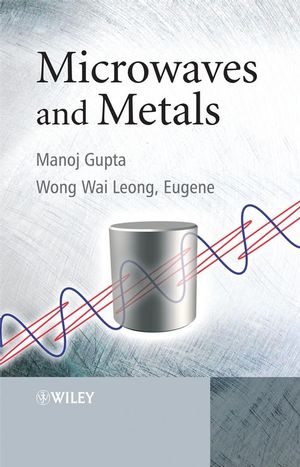|
Textbook
Microwaves and MetalsISBN: 978-0-470-82272-2
Hardcover
256 pages
November 2007, ©2007
 This is a Print-on-Demand title. It will be printed specifically to fill your order. Please allow an additional 10-15 days delivery time. The book is not returnable.
|
||||||
Acknowledgments.
1. Introduction to Microwaves.
1.1 Microwaves and Electromagnetic Radiation.
1.2 Development of Microwaves.
1.3 Applications of Microwaves.
1.3.1 Microwave Heating/Processing of Materials.
1.3.2 Communications.
1.3.3 Radio Detection and Ranging (Radar).
1.3.4 Electronic Warfare.
1.3.5 Medical Applications.
1.3.6 Scientific Applications.
1.3.7 Industrial and Commercial Applications.
1.3.8 Potential Applications.
1.4 Frequency Allocation.
1.5 Microwave Generators.
1.6 Summary.
References.
2. Microwaves – Theory.
2.1 Introduction.
2.2 Fundamentals.
2.2.1 Maxwell’s Equations.
2.2.2 Permittivity.
2.2.3 Permeability.
2.2.4 Power Dissipated.
2.2.5 Penetration Depth.
2.2.6 Rate of Increase in Temperature.
2.3 Microwave–Material Interactions.
2.3.1 Electronic Polarization.
2.3.2 Orientation or Dipolar Polarization.
2.3.3 Ionic or Atomic Polarization.
2.3.4 Interfacial (Maxwell–Wagner) Polarization.
2.3.5 Frequency Dependence of Polarization Mechanisms.
2.3.6 Conduction Losses.
2.3.7 Hysteresis Losses.
2.4 Summary.
References.
3. Microwave Heating.
3.1 Development of Microwave Heating.
3.2 Characteristics of Microwave Heating.
3.2.1 Penetrating Radiation.
3.2.2 Rapid Heating.
3.2.3 Controllable Field Distributions.
3.2.4 Selective Heating of Materials.
3.2.5 Self-limiting Characteristic.
3.2.6 Microwave Effects.
3.3 Types of Microwave Heating.
3.4 Future Developments.
3.5 Summary.
References.
4. Microwave Heating of Metal-Based Materials.
4.1 Microwaves and Metals.
4.2 Observations and Theories–Mechanisms Proposed for Microwave Heating of Metals.
4.2.1 Size and Morphology of Starting Materials.
4.2.2 Effect of Separate Electric and Magnetic Fields.
4.2.3 Sintering Behavior and Mechanisms.
4.2.4 Proposed Microwave Sintering Model by Luo et al.
4.2.5 Proposed Microwave Sintering Model by Rybakov et al.
4.2.6 Model for Microwave Heating of Metal Compacts.
4.3 Microwave Sintering of Metals.
4.3.1 Cermets.
4.3.2 Ferrous Alloys.
4.3.3 Copper Alloys.
4.3.4 Aluminum and Composites.
4.3.5 Magnesium and Composites.
4.3.5.1 Microwave Sintering of Magnesium Composites.
4.3.5.2 Effect of Microwave Heating Rate on Properties of Pure Magnesium.
4.3.6 Tungsten Alloys.
4.3.6.1 Effect of Particle Size Distribution and Phases on Densification.
4.3.6.2 Effect of Sintering Atmosphere on Densification.
4.3.6.3 Effect of Aspect Ratio of Samples on Densification.
4.3.6.4 Comparison of Sintering Methods on Densification.
4.3.6.5 Microwave Sintering of Nanocrystalline Tungsten Powders.
4.3.7 Tin-Based Alloys (Electronic Solders).
4.3.8 Hybrid Composites.
4.3.9 Layered Composites.
4.4 Other Applications for Microwave Processing of Metals.
4.4.1 Microwave Melting.
4.4.2 Microwave Steel-making.
4.4.3 Heat Treatment and Annealing.
4.4.4 Diffusion Coating.
4.4.4.1 Microwaves and Aluminization.
4.4.4.2 Microwaves and Chromization.
4.4.4.3 Microwaves and Boronization.
4.4.5 Surface Treatment.
4.4.6 Microwave Brazing and Bonding.
4.4.7 Microwave Plasma Processing of Metals.
4.4.8 Other Applications.
4.5 Summary.
References.
5. Microwave Heating of Other Materials.
5.1 Introduction.
5.2 Food Processing.
5.3 Ceramics Processing.
5.4 Polymer Processing.
5.5 Chemical and Pharmaceutical Processing.
5.6 Waste Remediation and Recycling.
5.7 Minerals Processing.
5.8 Biomedical Applications.
5.9 Other Applications.
5.10 Summary.
References.
Appendix A: Experimental Techniques in Microwave Processing.
A.1 Microwave Sintering of Cermets.
A.2 Microwave Sintering of Ferrous Alloys (1).
A.3 Microwave Sintering of Ferrous Alloys (2).
A.4 Microwave Sintering of Copper (1).
A.5 Microwave Sintering of Copper (2).
A.6 Microwave Sintering of Copper Alloys.
A.7 Microwave Sintering of Aluminum and Composites.
A.8 Microwave Sintering of Aluminum, Magnesium, Electronic Solders and Composites.
A.9 Microwave Sintering of Tungsten Alloys.
A.10 Microwave Heating in Separate E and H Fields.
Appendix B: List of Suppliers of Microwave Processing Equipment.
B.1 Types of Microwave Furnaces Available.
B.2 Manufacturers of Microwave Components and Thermal Insulation Materials.
B.3 Microwave Plasma Equipment.
B.4 Microwave Melting.
Appendix C: List of Research Groups in Metal-Based Microwave Processing.
C.1 Education and Research Institutes.
Index.



